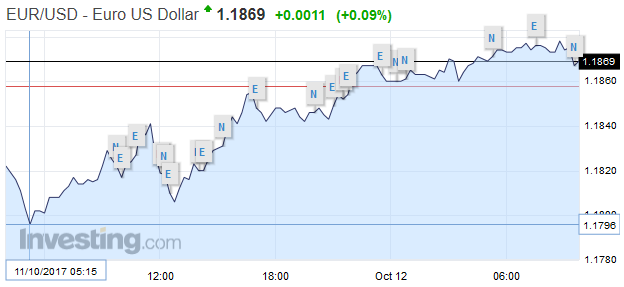Summary:
Euro peaked a month ago.
The reversal before the weekend marks the end of the leg lower.
ECB meeting is next big focus.
ECB may focus on gross rather than net purchases.
| The euro peaked a month ago near $1.2090. It recorded a low near $1.1670 after the weather-skewed US jobs data seen at the end of last week. The euro recovered from the weekend and set new session highs late US dealings. That reversal pattern marks the end of the month-long decline.
There has been follow-through euro buying this week, and the euro is approaching the 38.2% retracement objective of the decline since early September. It is found near $1.1830, near the 20-day moving average (~$1.1835), which the euro has not closed above since since September 22. The 50% retracement is near $1.1880. What concerns us is that the dollar’s rally coincided with heightened expectations of a Fed hike in December, and a rate hike has now been nearly fully discounted. The implied yield on the December Fed funds contract is 1.265%. In our work, assuming no chance of a November move, a 25 bp rate hike at the December meeting, and that effective Fed funds rate falls 10 bp, as it has been doing at the end of a quarter, at the end of December, fair value is near 1.29%. It so happens too, that the US 10-year yield rose to 2.40%, which is the upper end of its six-month range. The good news has been priced in for the dollar and yields and keeping in mind the technical considerations; the risk is of a corrective phase. Also, the ECB meets on October 26. This is an important meeting. The ECB is expected to announce its plans for its asset purchase program. The current commitment expires at the end of the year. |
EUR/USD - Euro US Dollar, October 11(see more posts on EUR/USD, ) |
With the highest confidence, we can say that the ECB’s purchases will not stop cold at the end of the year. They will continue, even as the Fed’s balance sheet begins to shrink. The main focus is on the trade-off between the length of the program (duration) and the size (of the monthly purchases. Our insight that policymakers see this as a trade-off has now been underscored by the ECB’s chief economist. There is increased talk of a large cut in monthly purchases and extending the program well into next year (more than six months).
There is another moving part that few have considered. Currently, the Eurosystem is buying 60 bln euros of assets a month. Starting next year, the Eurosystem faces maturing issues that will average about 15 bln euros a month, according to reports. The ECB has indicated it intends to reinvest the maturing proceeds like the Fed has been doing (and will gradually reduce the amount being recycled starting this month).
This means that in addition to its new monthly purchases; it will also be buying to replace the maturing amount. The ECB may offer a gross amount of purchases, which includes the recycled figure and the net new purchases. That would mean that the amount it buys on a gross basis will not all translate into a large balance sheet. Only the new net purchases add to the balance sheet.
European officials seem more concerned about the euro when it trades above $1.20. The issue is whether Draghi can succeed in convincing the market that of a dovish tapering. He will likely emphasize the sequence. A rate hike will not be delivered until the asset purchases are complete. The new expansion of the ECB’s balance sheet may run six to nine months (though there is some talk of a full year, which seems too large a commitment at this juncture). Meanwhile, with shifts in the composition of the Federal Reserve expected in the coming months, the market is reluctant to take the Fed’s dot plots, which point to three hikes as being appropriate next year, too seriously.
Full story here Are you the author? Previous post See more for Next post
Tags: #USD,$EUR,ECB,EUR/USD,Federal Reserve,newslettersent








































